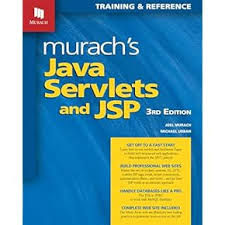A Deep Dive into Java Web Development with Murach's Resources
This white paper explores the comprehensive learning path offered by Murach's "Java Programming" and "Java Servlets and JSP" books. It examines the core concepts, practical applications, and real-world use cases that these books cover, making them invaluable resources for aspiring and experienced Java web developers.
1. Foundational Java with "Murach's Java Programming"
- Core Concepts:
- Object-Oriented Programming (OOP): This book provides a strong foundation in OOP principles, including classes, objects, inheritance, polymorphism, and interfaces. These concepts are fundamental to Java and essential for building robust and maintainable applications.
- Data Structures: It covers essential data structures like arrays, ArrayLists, and HashMaps, enabling efficient data organization and manipulation.
- Exception Handling: The book emphasizes the importance of robust error handling mechanisms to prevent application crashes and improve stability.
- File I/O: It explores file input/output operations, allowing developers to interact with files and external data sources.
- GUI Development: It introduces basic GUI programming concepts using Swing, enabling developers to create user-friendly interfaces for their applications.
- Practical Applications:
- Building Desktop Applications: The book equips readers with the skills to develop various desktop applications, such as calculators, inventory management systems, and simple games.
- Preparing for Web Development: The core Java skills learned from this book are essential prerequisites for web development using Java technologies like Servlets and JSP.
2. Web Application Development with "Murach's Java Servlets and JSP"
- Core Concepts:
- Servlets: The book delves into the fundamentals of Servlets, explaining how they act as the foundation for Java-based web applications. It covers key aspects like handling HTTP requests and responses, session management, and servlet life cycle.
- JSP (JavaServer Pages): It introduces JSP technology, which allows developers to embed Java code within HTML pages, making it easier to generate dynamic web content.
- MVC (Model-View-Controller): The book emphasizes the importance of the MVC architectural pattern for organizing web applications, promoting code reusability and maintainability.
- Database Connectivity: It covers JDBC (Java Database Connectivity), enabling developers to interact with databases (such as MySQL, Oracle) to store and retrieve data for web applications.
- Web Application Security: The book addresses essential security considerations, such as preventing SQL injection, cross-site scripting (XSS), and other common web vulnerabilities.
- Practical Applications:
- Building E-commerce Websites: The book provides the necessary knowledge to develop online stores, including user registration, product catalogs, shopping carts, and order processing.
- Creating Content Management Systems (CMS): It equips readers with the skills to build CMS platforms for managing and publishing web content.
- Developing Enterprise Applications: The book lays the foundation for building large-scale enterprise applications, such as customer relationship management (CRM) systems and business intelligence dashboards.
3. Real-World Use Cases
- E-commerce Platforms: Many popular e-commerce platforms, such as Amazon and eBay, leverage Java technologies like Servlets and JSP for their backend operations.
- Social Media Platforms: Social media giants like Facebook and Twitter utilize Java for various aspects of their infrastructure, including user management, data processing, and content delivery.
- Financial Services: Banks and financial institutions use Java for developing secure online banking systems, trading platforms, and risk management applications.
- Healthcare: Java is widely used in the healthcare industry for developing electronic health records (EHR) systems, patient management systems, and telemedicine applications.
- Cloud Computing: Java plays a crucial role in cloud computing platforms like AWS and Google Cloud, powering various services and applications.
4. Key Benefits of Using Murach's Books
- Clear and Concise: Murach's books are renowned for their clear, concise, and easy-to-understand writing style, making them accessible to both beginners and experienced programmers.
- Practical Focus: The books emphasize practical, real-world applications, providing numerous examples and hands-on exercises to reinforce learning.
- Step-by-Step Guidance: The books provide detailed, step-by-step instructions and code examples, making it easier for readers to learn and implement concepts effectively.
- Industry-Relevant Content: The content is regularly updated to reflect the latest industry trends and best practices in Java web development.
5. Conclusion
Murach's "Java Programming" and "Java Servlets and JSP" books offer a comprehensive and effective learning path for anyone interested in mastering Java web development. By combining strong foundational knowledge with practical, real-world applications, these books empower readers to build robust, scalable, and secure web applications that meet the demands of today's dynamic digital landscape.
References:
- Murach, J. (2023). Murach's Java Programming. Mike Murach & Associates, Inc.
- Murach, J. (2023). Murach's Java Servlets and JSP. Mike Murach & Associates, Inc.
Note: This white paper provides a general overview. The specific content and examples may vary depending on the latest editions of the books.
I hope this comprehensive white paper provides valuable insights into the learning journey offered by Murach's Java books. Contact ias-research.com for details.



